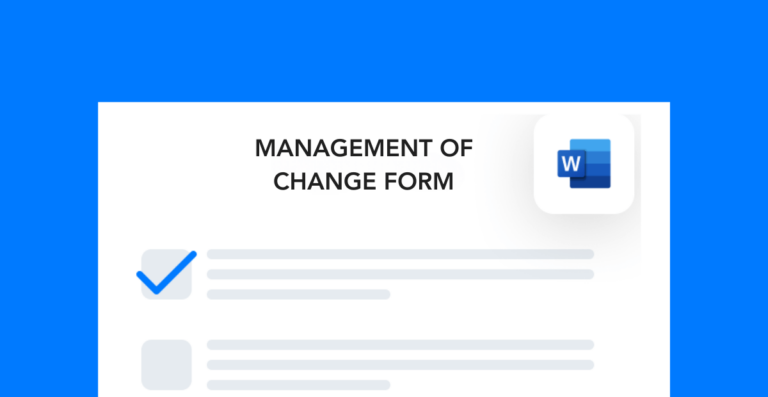What is management of change (MOC)?
Changing business conditions require changes to raw materials, finished products, and operating parameters. Vendors develop new and improved equipment and instruments. Pieces of equipment need repairs.
The management of change, or “MOC,” process ensures that these types of changes don’t have a negative impact on your operation. With a more methodical approach, it’s easier to track critical tasks that can affect the safety of process or equipment modifications.
The history of MOC
In 1974, workers at a Nypro plant in Flixborough, UK installed a temporary 20-in. pipe which bypassed a damaged reactor and allowed the plant to operate while the reactor underwent repairs. Three months later, the pipe failed and released 30 tons of flammable cyclohexane. The ensuing vapor cloud explosion killed 28 people and injured 89 others.
Similarly, a 1984 disaster in Bhopal, India occurred when a runaway reaction resulted in the release of methyl isocyanate (MIC). The MIC cloud left the plant and drifted over the neighboring town, killing thousands and injuring tens of thousands.
Because of these incidents, other accidents in the U.S., and inconsistent change management practices in the chemical and refining industries, OSHA enacted the process safety management (PSM) regulation in the early 1990s. One of the key components of the PSM regulation is management of change (MOC).
Benefits of MOC
The MOC process has many advantages, not all of which relate to safety. MOC benefits businesses by:
- Minimizing unplanned adverse impacts on system integrity, security, stability, and reliability
- Maximizing the productivity and efficiency of staff planning and coordination
- Providing a stable production environment
- Ensuring the proper level of technical completeness, accuracy of modifications, and testing of systems before implementation
- Providing an appropriate level of management approval and employee involvement
Because MOC forces you to take a calculated approach, it introduces organization throughout your facility. This makes your workers’ jobs easier and ensures that the systems you have in place comply with OSHA regulations.
Steps for implementing an MOC system
When you implement an MOC system, it needs to be all-inclusive. It should address minor changes and major capital projects, as well as both temporary and permanent changes.
Some companies have developed “one-size-fits-all” MOC processes that are used for every change, while other companies find it easier to have multiple MOC systems. You can split multiple systems based on the type of change (equipment vs. procedural), the duration (temporary vs. permanent), or the size of the change (minor vs. major).
Another consideration is whether to use an electronic MOC process. The important thing to remember is that your approach should be flexible, easy to use, and as seamless as possible with your current systems.
A basic MOC process contains eight main steps that you should follow each time you implement a change. Below, we review each step in more detail.
Initiation
In the initiation step, any employee can propose a change to procedures, equipment, etc. within the PSM-covered process. MOC forms allow the initiator to document the proposed change. The initiator then forwards the information to one or more members of the facility management team for review and approval.
Preliminary review
The preliminary review consists of a “go/no go” decision which is based on the information supplied by the initiator. This may include discussions between the initiator and the reviewers to clarify the details of the proposed change.
If the review team decides to proceed with the change, the preliminary reviewers should, as much as they are able, provide feedback on the:
- Technical basis for the change
- Impact on safety and health
- Timeframe to accomplish the change
If the change is temporary, preliminary reviewers should also ensure that the end date for the temporary change is included in the MOC documentation.
Risk assessment/technical review
This step is one of the most important activities within the MOC process. It is critical to involve the facility engineer, technical authority, or someone with a deep understanding of the process in this step.
A risk assessment should match the complexity of the change. For minor changes, it may be okay to ask the question “what if?” But more complex changes require tools like process hazard analysis or failure mode-effect analysis.
Some companies also find it useful to include a risk assessment checklist in their MOC process. The checklist includes questions like:
“Does this change involve a shutdown or safety system?”
“Does this change increase or decrease the pressure, temperature or flow rates within the process?”
The completed checklist can be the risk assessment itself. It can also point the user toward a more sophisticated risk assessment tool or additional review by safety, environmental or technical experts. Regardless of the risk assessment method, it’s important to document what could reasonably go wrong and the steps to prevent it.
Approval to design/construct
Facility superintendents or managers typically grant you to start this step of the process. These people commit resources towards completion of the change and agree that the change can be safe based on the information provided.
Design/construct/pre-commissioning
Most of the heavy lifting is accomplished during this step. At this time, the team completes final designs, constructs equipment, updates procedures, and verifies equipment installation.
If the design changes during this step, another round of risk assessment and approval is critical to ensure that you manage risks associated with the new design.
Pre-startup safety review (PSSR)
The PSSR step consists of the set of verifications and assurances that the team has properly completed each portion of the work. PSSR items are typically assigned to multiple people, such as facility engineers, operations leaders, and maintenance leaders.
A PSSR must verify that:
- Equipment meets the design specifications and is properly installed
- Adequate safety, operating, maintenance, and emergency procedures are in place
- Process hazard analyses are completed for new facilities and recommendations are resolved before startup
- Employees involved in operating the PSM-covered process are trained on or notified of the change as appropriate
- Safe work practices are revised accordingly
- Process safety information that employees use is updated accordingly
- Future items are assigned for completion
Approval to start up
Once the PSSR is complete, the MOC is forwarded to the facility superintendent or manager for startup approval. By granting startup approval, the manager or superintendent is confirming that the requirements of MOC and PSSR have been completed properly and that the change is safe to start or to make active.
Because of this, the superintendent or manager should have a solid understanding of the facility MOC process as well as the requirements of OSHA’s PSM standard.
Follow-up activities
As mentioned, follow-up activities need to be assigned to individuals for completion. The MOC process should be comprehensive enough to ensure that these items are not forgotten. Most companies will not close an MOC until the follow-up activities are completed.
Improving your MOC process
The best way to ensure that the MOC process is working is to conduct periodic self-assessments or reviews. Anyone with a solid understanding of the MOC process can complete a review of it. It’s often best to have a person outside the department perform the review.
This gives a level of independence to the review and helps find problems that someone inside the system may overlook. Many companies use a checklist or other guide to help obtain consistent results. The results can then be used for individual coaching or to indicate areas of improvement.
Compile safety information on the products, equipment, materials, or processes that are changing and make them easily accessible, so you can update them when MOCs necessitate it.
Common MOC problem areas
Some MOC processes attempt to be a “one-size-fits-all” system. As a result, they are so complex that users find it difficult to complete an MOC. This creates frustration and can cause people to bypass the process for small changes because it’s not worth the effort.
To avoid this, consider having separate MOC processes for small changes or changes to procedures and documentation. You can also try having a simple base MOC process that includes supplemental checklists or features that you only use when needed.
Notification and training of affected employees
OSHA’s PSM regulation is a bit of a gray area when it comes to training requirements. A facility is required to train and/or notify affected employees of the change, but there are no requirements to document the MOC training.
To avoid problems in this area, it’s best to follow the “If you didn’t write it down, you didn’t do it” approach. Some facilities have a binder in the control room or maintenance shop with copies of the MOC and rosters so that employees can review it and sign off.
Others use electronic systems or e-mail to document communication and training. Either method is fine so long as you ensure that employees returning from time off review the MOC information when they return.
Startup is granted before approval
Occasionally, a site makes changes prior to receiving startup approval. Reasons for this include emergency changes during weekend or night shifts, superintendent/manager vacation, or misunderstanding that another approval is needed before startup can occur.
To handle changes when the approvers are not available, some facilities delegate approval authorization to facility operations leaders and shift leaders. Others have a rotating on-call process where other superintendents and managers approve another department’s MOCs.
In the case of miscommunication regarding the second approval for startup, well-written MOC procedures with clear expectations for each step are critical. Flowcharts and process maps are also helpful.
Follow-up activities remain incomplete
Some companies use MOC software to automatically send MOC task notifications and to generate tracking reports. Even these systems can fall short if the loops aren’t closed. Periodic reviews, as described here, can also help identify when follow-up activities are not completed.
Temporary changes lasting forever
Pipe leak-repair clamps and bypass lines that have been around a long time are both examples of temporary changes that evolve into semi-permanent and permanent changes. Some companies attempt to avoid this situation by setting limits for how long temporary changes can be in effect. MOC expiration dates of 120 to 180 days are typical.
Other facilities conduct technical reviews and reauthorize temporary MOCs on a quarterly, semiannual, or annual basis to ensure that the operating conditions have not changed and that the temporary change is still safe to operate. Like follow-up activities, diligence and periodic reviews are the best ways to prevent temporary changes from evolving into permanent ones.
Incorporating a MOC system into your operations
Management of change helps businesses meet OSHA’s PSM regulations, but its benefits reach beyond compliance. A simple MOC system ensures that your team understands and properly manages important documentation. It also ensures that employees learn how to follow a standard procedure, that equipment stays in excellent condition, and that there are sufficient safeguards in place.
Other posts you might like…
No posts


